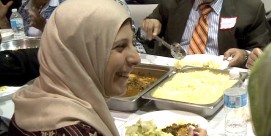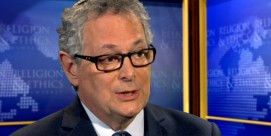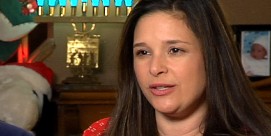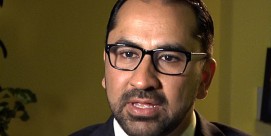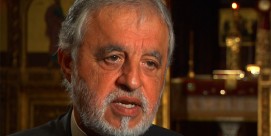In This Episode << SLIDE LEFT TO SEE ADDITIONAL SEGMENTS
Nancy Ammerman Extended Interview
Read more of Kim Lawton’s interview with Nancy Ammerman:
What do you consider the essence of American Protestantism to be?
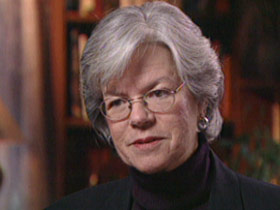
Protestantism in the United States has from its beginning been characterized by the fact that people gather into voluntary local congregations — that a group of lay people get together and form a congregation on their own. Even if they have a bishop in the United States, one of the things that’s been really important is that lay participation, that lay control, that local sense of indebtedness in a particular, local congregation.
And how has Protestantism been tied up with the history of the United States?
Among the first settlers from the European continent who came here, of course, were people that we think of as the Pilgrims, the Puritans, who came here for religious reasons and were Protestants. [They] were very much a part of that voluntary tradition [and] came here to be able to set up a community of people who could worship together and live together under the dictates of their particular understanding of how they should live together as Christians. That pattern of people gathering into local communities and a congregation is one that has really formed the model, the template, that other religious traditions have tended to follow once they come here.
Is there something in the American ideal that fits so well with Protestantism, or is it the other way around? Did the Protestant tradition help form the American ideal?
I think it’s a little bit of both. It certainly is the case that throughout our history the fact that people have been gathering into these local congregations where they’ve been self-governing, where they have had to make decisions together — that has been an important school of democracy. Clearly [it is] one of the things that fed into the formation of the United States Constitution and the way this country is put together, and it continues to be an important part of our civic culture. People who participate in local congregations are more likely to vote. They are more likely to have the skills to be effective participants in the larger political process. The two things are really very closely tied together.
Protestantism began in Europe, but did America really become the key breeding ground for it?
Even in Europe, most of the Protestant churches were still tied to the state, tied to a particular place. Everybody in a particular area was Lutheran or, in Geneva, Calvinist. In the United States, what began to happen very early was that the tie between place and state on the one hand and religious tradition on the other began to get broken. We mixed things up in the United States much more than they ever did in Europe. There’s a very particular brand that the United States has placed on Protestantism, and Protestantism on the United States.
You talk about forming voluntary associations and about a democratic way of working things out together. But isn’t there also a rugged individualism to this brand of religion?
There certainly is. One of the things that Protestantism has stood for is the individual finding a relationship with God. Different kinds of Protestants put more and less emphasis on the individual or on the church as a mediator. But in all of Protestantism, the notion of the individual having that unmediated relationship with God is important. That has been very much a part of the American way of thinking about religion — that we each choose our religion. It’s not something that’s thrust upon us by birth, by where we are as children. Again, there is that back and forth between the American way of being, that rugged individualism, and the Protestant emphasis on the priesthood of all believers.
How did Protestant diversity develop, and what does it signify?
Once you let people make their own choices, and once you emphasize local communities really having some autonomy and the ability to gather together and form their own congregations, then what you open up is the possibility that when a new group of people comes along and doesn’t exactly fit with the old group that was there, they can go off and start their own congregation. They can start their own denomination. What we’ve seen over the course of U.S. history is an incredible proliferation of religious groups, particularly Protestant groups, and that ability to start something new if you don’t like what already exists has been the impetus. Today we do have just hundreds of different kinds of Protestants in this country.
What are some of the key trends driving Protestantism?
One of the most important things happening in Protestantism at this point is the increasing diversity of the American population. We have to go back more like 30 or 40 [years], really, to get a handle on how significant this change is. If you had asked most Protestant congregations 40 years ago about their own ethnic composition, the vast majority of them would have said that they are predominantly one race and, in fact, probably would have told you that they are exclusively one race, either black or white or a minority of Hispanic and Asian and other racial groups. But what we’ve found in the last few years is that very few congregations claim to be exclusively one race. Everybody wants to claim at least some diversity within their congregation. And the fact that that’s a badge of honor seems to me a real change in the way we think about congregational life. When we actually count them up and look to see whether they’re as diverse as they think they are, in some cases they’re not. But what we did find is that only about 60 percent of congregations in this country are predominantly white, to [the] point that they have 10 percent or fewer of some other racial category within them. There is actually more diversity within congregations today than there certainly would have been 10 or 15 or 20 years ago.
And what are the theological implications of that?
I think it’s more a matter of theology driving diversity than the other way around. Many American Protestants in the last generation simply became convinced that a racially exclusive congregation was not theologically defensible. They have become much more intentional about trying to be open to people who are different from themselves. That’s not at all to say this is an accomplished task. It’s just to say that we have come a very long way in a generation in this regard. But even more important than that, we still see É many, many congregations that are predominantly of one ethnic group or other, and, of course, with immigration that ethnic array has broadened much in the last generation as well. A bigger slice of the American Protestant pie is now Korean Presbyterian[s] and Hispanic Pentecostals and people who are coming from all over the world and becoming a part of the overall Protestant mix.
The RELIGION & ETHICS NEWSWEEKLY/U.S. NEWS & WORLD REPORT national survey found a high level of religious observance but also high levels of tolerance for religions outside one’s own. But while people said they were very tolerant, they also had high levels of ignorance about other religions. They didn’t even know people of other faiths. How do you explain all of that?
American society has established some pretty strong norms about tolerance that, with the most recent generations, have become even stronger. Even evangelicals, for whom proselytizing and trying to convert people of other faiths is central to who they understand themselves to be, don’t want to be obnoxious in their proselytizing. They want to be respectful and not push their faith on somebody else. There’s a very strong sense that we should respect each other, and that respecting each other includes respecting the religious traditions that other people have. Now that’s all fine in theory. And mostly what it does is let us get along where our particular religious beliefs aren’t at issue. It lets us live together in neighborhoods and work together in our communities. Our kids go to school together without any huge conflicts that are precipitated simply by a kind of blanket condemnation of people who are different from us. Am I going to want to worship together with somebody who’s from a different tradition? Probably not. Do I think they are right? Probably not, most Americans would say. Do I even know what they believe? Probably not, as most Americans experience it. It’s a kind of tolerance that allows us to work together without necessarily having to get into the fine points of, do we really agree?
Do you see this as a potential area of tension? As diversity grows, as we experience events like September 11, as members of some minority religious groups end up running for the school board or mayor, will this level of ignorance — and tolerance — really be challenged?
Inevitably we will run into situations where, out of people’s religious traditions, there are practices people find difficult to get along with. Already we are obviously running into all kinds of things. Is it O.K. for a Sikh young man to wear his turban? Is it O.K. for a Muslim young woman to wear the hijab? Is it O.K. for an airline employee to wear distinctively religious garb? There are all kinds of ways in which various religious practices impinge on that public space that we all share together and all kinds of ways that those things are being negotiated now. My sense is that there is going to be a really mixed picture. There will be times when tempers will flare, and we will have conflict. And there will be times when once we see why something is important to somebody, people will say, “Well, sure, that’s not a problem; we can work that out.” We’re just in for a generation or so of figuring out that balance between particularity and difference, on the one hand, and getting along and all looking alike and sounding alike and being alike.
What trends do you see in people’s ties to their denominations?
One of the things that’s probably new in the last generation is that the average Protestant church finds within its pews that at least half of the people there did not grow up within the denomination of that church. The average Protestant church is a mix of about half, or maybe a little more, of people who are cradle Episcopalians, or Lutherans, or Presbyterians, and people whom sociologists tend to refer to as “switchers.” It’s not only liberals who switch across denominations. This is really characteristic of Protestantism across the board. Every congregation is now faced with the question, “Are we simply going to be a generic congregation, or are we going to emphasize the particular denominational tradition of which we are a part?” If we choose the latter road, congregations have to get intentional about teaching their tradition in a way they would not have in the past. When everybody in the pew has grown up in the tradition, you can assume a lot about whether they know when to sit down and stand up, when to kneel, when to do this and that, how to find something in the hymnal, how to use the prayer book — they just absorb it as they’re growing up. If you grow up Methodist and join a Lutheran church, you’re going to have to learn some things if you are really going to be a Lutheran. One ironic consequence is that people who choose to teach people about their tradition end up with people who actually know more and, in many cases, value the particular denominational heritage in a way that the people who grew up in it don’t always do.
Along with lost denominational loyalties, is there an identity issue as well?
All Protestant denominations really are facing some very serious identity questions. I would be misleading you if I said they’ve all got them solved, and they’re moving in the direction of a renewed sense of identity. That certainly is not the case. We do find that the levels of switching among the denominations have a very real effect on the sense of identity and loyalty in those congregations. The congregations with the highest levels of switching are less likely to be loyal to their denomination. But it’s also important to say that’s not a universal trend, and there is a countertrend: those congregations that are the most mobile and the most full of switchers and the most highly educated, precisely the ones you think would say that denominations are passŽ, are saying no, I really want to know what it means to be an Episcopalian. I want to know what it means to be a Lutheran. I want to study about it, and I want to learn and really invest in an identity and a tradition. We see both kinds of things going on, both a re-valuing of identity and an erosion of identity.
Is it bad that people don’t have the ties and the loyalties, or could it also be positive? Divisions that kept people at odds for so many years may not seem that essential or important, and now people are coming together.
Certainly for most of the twentieth century, people have worried about denominationalism. They have worried that Christianity was divided up into all these branches or wings that were primarily defined by region or race or ethnicity rather than anything very theological. One of the movements over the course of the century was in the direction of reuniting, moving people back together, merging denominations, minimizing denominational differences. That’s one of the things that has made it possible to move back and forth across denominational lines. The people leading denominations and congregations have tended to minimize those differences and say, “What really matters is that we’re all Christians. That’s the most important identity.” You’ll certainly find many evangelicals, for instance, who will say, “What’s most important is I’m a born-again Christian. It doesn’t matter whether I’m evangelical, covenant, or Southern Baptist.” We find both a positive benefit to people not demonizing each other and not being separate from each other and declaring that all Methodists are going to hell — that certainly has been a step forward in minimizing these denominational differences. But at the same time we recognize that there are some particular stories and histories and traditions and rituals that each denomination had kept alive. And those stories and rituals and traditions are important for a sense of rootedness, particularly in a very mobile society.
What about the growth of nondenominationalism — people who don’t want to have any denominational ties whatsoever?
Certainly we do see that as a growing segment of American Protestantism. One of the things churches that declare themselves to be nondenominational are claiming is that a denomination is the sort of thing that divides people and is an evil to be avoided. What they want to do is simply put an emphasis on the basic Christian message, particularly the evangelical Christian message. We do see that as a growing segment of the American Protestant picture. One of the ironies is that there is a distinct identity to being nondenominational. It’s almost as clear a badge of where do I sit within Protestantism as if you were a Lutheran. To say “I’m a member of a nondenominational church” is not to say, “I’m without a particular identity within the larger picture of Protestantism.”
What about the tension between creeds and doctrines and experience? The RELIGION & ETHICS NEWSWEEKLY/U.S. NEWS & WORLD REPORT survey found that doctrines seem less important to people and commitment to beliefs seems to be softening a bit. Strong numbers of people still say doctrines are the most important reason for choosing a church, but there is also an emphasis on spiritual experience. How great a tension is that within Protestantism?
My hunch is that you would find some real difference depending on the particular stream within Protestantism in which you’re looking for answers to that question about doctrine and experience. Much of evangelicalism does, in fact, emphasize particular beliefs as really critical: it’s important that you believe that Jesus Christ is the only begotten Son of God. It’s important that you believe that Jesus rose from the dead. It’s important that you believe that the Bible is true. Those kinds of central doctrines and beliefs really define that community, and people within that community would be loath to join up with a church that didn’t affirm those beliefs. It seems to me that in much of Protestantism the experience of worship — the sacraments in the Episcopal tradition, for instance, the Eucharist — are also going to be very important to people. Likewise, within the Pentecostal wing of evangelicalism, the experience of the Spirit is going to be a central, defining component to understanding how belief takes shape. You can say all day long that you believe this, that, and the other, but if you haven’t been “baptized in the Spirit,” then for a Pentecostal it doesn’t really count. Protestantism today, it seems to me, is a real mix of different streams that emphasize belief or experience differently.
It’s not a contradiction for some Protestants to emphasize both?
My guess is that most clergy in most of Protestantism would tell you that belief is important. The clergy are, after all, the theologians. They are the ones who are going to make their livelihood by talking about beliefs and expounding on them. Even within traditions where belief is defined as the central characteristic, my hunch is that the people in the pews mix belief and practice or belief and experience a little more than what you would necessarily hear if you were simply listening to a sermon. Even if people in the pews say that belief in Jesus as my Savior is the most important thing, what’s also important is that I can pray to Jesus and experience Jesus’ presence in my life. For most people, that mix of belief and experience is just the way religion is for them.
Are there other key challenges you see for American religion in general and Protestants in particular?
Many American Protestant congregations were founded 100 or 150 years ago in the countryside, or in sections of cities that have gone through transition after transition. When a congregation is that old and has been through that many rounds of transition, it’s difficult to sustain. So much of what various Protestant denominations are dealing with is that they’ve got lots and lots of small congregations scattered all over the place — many of them full of people who are relatively old and can’t afford a full-time pastor. There are some organizational dilemmas that are demographic and historic that American Protestant denominations are going to have to deal with in the next 25 to 30 years. I think we’ll see a lot of organizational stress and strain within those denominational traditions, at the same time that we see new congregations being founded all the time and mega-churches growing up on the edges of the cities and new religious traditions coming into the picture and all of the rest. There is an enormous amount of vitality at the same time that there is stress and strain.
What about the interfaith future?
One of the things that September 11 really reminded us of is that we are living in a much more religiously diverse society. Protestants can’t assume that they’re in charge. They can’t assume that everybody around them is Protestant. They can’t even assume that everyone around them is either Protestant or Catholic. There is an awareness of the religious diversity in this country that really wasn’t there until September 11. Protestants are dealing with both that sense of loss and grief, of recognizing that they’re not in charge and not the center of things anymore, but [also] the positive side of recognizing that they do need to get into conversations and coalitions with people who have not typically been included in the circle of partners they have worked with. When people put together a coalition to work on homelessness or a task force to deal with teen drug problems, instead of simply calling the Methodist church and the Baptist church and the Episcopal parish down the street, the Catholics are going to be included, the synagogue may be included, the mosque may be included, the Hindu temple may be included. How do we really build those working coalitions and learn about each other in the process as we work together on problems we face together?
Some people say the extent of our religious diversity is overstated. Over 80 percent of the country is still Christian and still pretty powerful.
It is certainly the case that Christians are very much the majority. This country makes lots of Christian assumptions in our culture. Just the way we do things very much builds on the fact that we have been a predominantly Christian culture for a very long time. It would be a big mistake to assume that Hindus who come here can just fit in and be at home overnight. They know they are walking into a Christian culture probably far more than those of us who are Christian recognize all the subtle ways we have shaped the culture.
Do you think “we’re all Protestants now”?
There is a sense in which that Protestant model for how you think about individual religion and the local congregation is shaping the experience of all kinds of religious traditions in this country. The notion that a local group of people can get together and form a congregation, have a lay board of directors, and have some say over exactly how they program what they do in their local gathering of people — even the notion that you have programming, that you do something other than simply gather to participate in the particular religious rituals that are part of your tradition — is Protestant. Having a women’s group, for example, very much comes out of the Protestant model. The notion that an individual is going to choose how to be religious and how religious to be and which religious tradition to be a part of — that’s very much out of a Protestant notion of the individual having to be responsible for his or her relationship with God.

